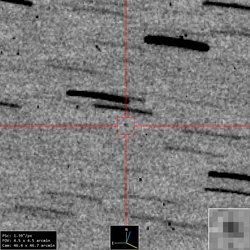Astronomy:2013 JX28
| Discovery[1] | |
|---|---|
| Discovered by | Pan-STARRS 1 |
| Discovery date | 11 May 2013 (25 May 2006) |
| Designations | |
| 2006 KZ39 | |
| Minor planet category | Atira (Aten asteroid subclass) Near-Earth object[2] |
| Orbital characteristics[2] | |
| Epoch 13 January 2016 (JD 2457400.5) | |
| Uncertainty parameter 1 | |
| Observation arc | 2893 days (7.92 yr) |
| |{{{apsis}}}|helion}} | 0.9397700 astronomical unit|AU (140.58759 Gm) (Q) |
| |{{{apsis}}}|helion}} | 0.2618791 AU (39.17656 Gm) (q) |
| 0.6008245 AU (89.88207 Gm) (a) | |
| Eccentricity | 0.5641339 (e) |
| Orbital period | 0.47 yr (170.1 d) |
| Mean anomaly | 78.308816° (M) |
| Mean motion | 2.116326°/day (n) |
| Inclination | 10.76379° (i) |
| Longitude of ascending node | 39.96294° (Ω) |
| 354.88173° (ω) | |
| Earth MOID | 0.0685652 AU (10.25721 Gm) |
| Jupiter MOID | 4.48856 AU (671.479 Gm) |
| Physical characteristics | |
| Dimensions | ~300 m[3] |
| Absolute magnitude (H) | 20.1[2] |
2013 JX28 (also known as 2006 KZ39) is an Atira asteroid, a type of Aten asteroid, that orbits entirely within Earth's orbit. It orbits very close to the Sun, having the eighth smallest semi-major axis of any minor planet in the Solar System. At its closest, it is only 0.26 astronomical unit|AU (39,000,000 km; 24,000,000 mi) from the Sun, but more than 100 minor planets have a smaller perihelion distance.
Despite being officially classified as a near-Earth object, 2013 JX28 has a MOID (minimum orbit intersection distance) with Earth of ~0.067 AU,[2] making it highly unlikely to ever hit Earth. For comparison, the Moon orbits Earth at about 1/26th this distance.
Physical characteristics
2013 JX28 has an absolute magnitude (H) of 20.1,[2] which means it is rather small, with the size being approximately 300 meters based on an assumed albedo of 0.15.[3] Its albedo is not known, so a size estimate is not certain. Assuming the albedo is between 0.05 and 0.25, it is somewhere between 260–580 meters in diameter.[4]
163693 Atira, an asteroid with an orbit similar to 2013 JX28, for comparison, has an absolute magnitude of 16.28 and is notably larger.
Close approaches
As a near-Earth object,[2] 2013 JX28 often comes within 0.1 AU (15,000,000 km; 9,300,000 mi)] of Earth. On 29 April 2014, it traveled to 0.0843 AU from Earth, about 33 times further than the Moon. Below is a list of close approaches until 2100 where 2013 JX28 travels closer than 0.1 AU to Earth.
| date | distance (AU)[2] |
|---|---|
| 2000-04-20 | 0.0913 |
| 2007-04-25 | 0.0682 |
| 2014-04-29 | 0.0843 |
| 2034-04-21 | 0.0888 |
| 2041-04-25 | 0.0680 |
| 2048-04-29 | 0.0849 |
| 2068-04-21 | 0.0863 |
| 2075-04-26 | 0.0676 |
| 2082-04-30 | 0.0890 |
References
- ↑ "List Of Aten Minor Planets (by designation)". IAU minor planet center. http://www.minorplanetcenter.net/iau/lists/t_atens.html. Retrieved 9 February 2014.
- ↑ 2.0 2.1 2.2 2.3 2.4 2.5 2.6 "2013 JX28". JPL small-body database. Jet Propulsion Laboratory. http://ssd.jpl.nasa.gov/sbdb.cgi?sstr=2013JX28;cad=1. Retrieved 3 April 2016.
- ↑ 3.0 3.1 "Conversion of Absolute Magnitude to Diameter". SFA texas university. Physics and astronomy department. Archived from the original on 23 July 2011. https://web.archive.org/web/20110723191750/http://www.physics.sfasu.edu/astro/asteroids/sizemagnitude.html. Retrieved 9 February 2014.
- ↑ "Absolute Magnitude (H)". NASA/JPL. http://neo.jpl.nasa.gov/glossary/h.html. Retrieved 2014-02-15.
External links
- JX28&pc=1.1.0 2013 JX28 at NeoDyS-2, Near Earth Objects—Dynamic Site
- JX28 2013 JX28 at ESA–space situational awareness
- 2013 JX28 at the JPL Small-Body Database
 |


